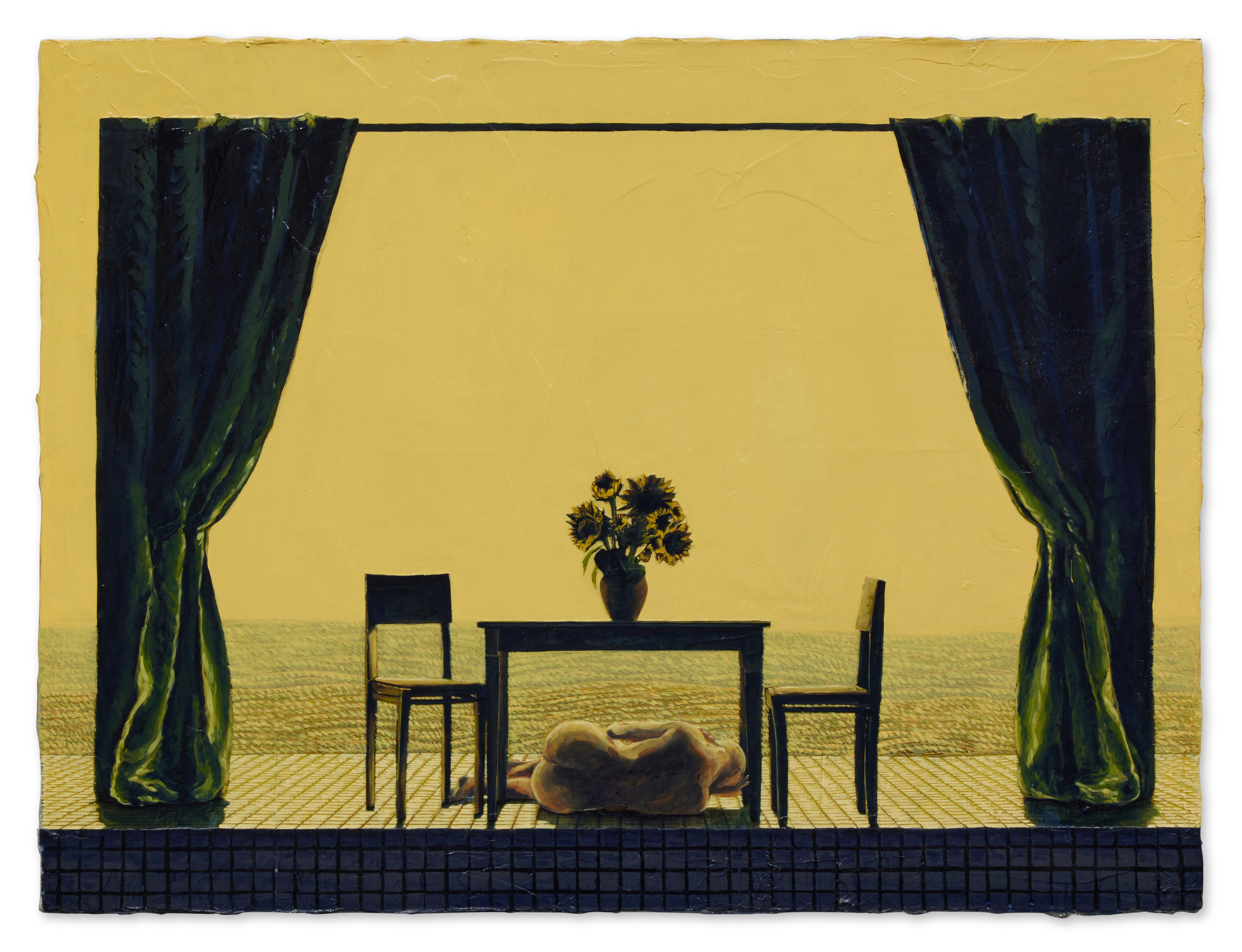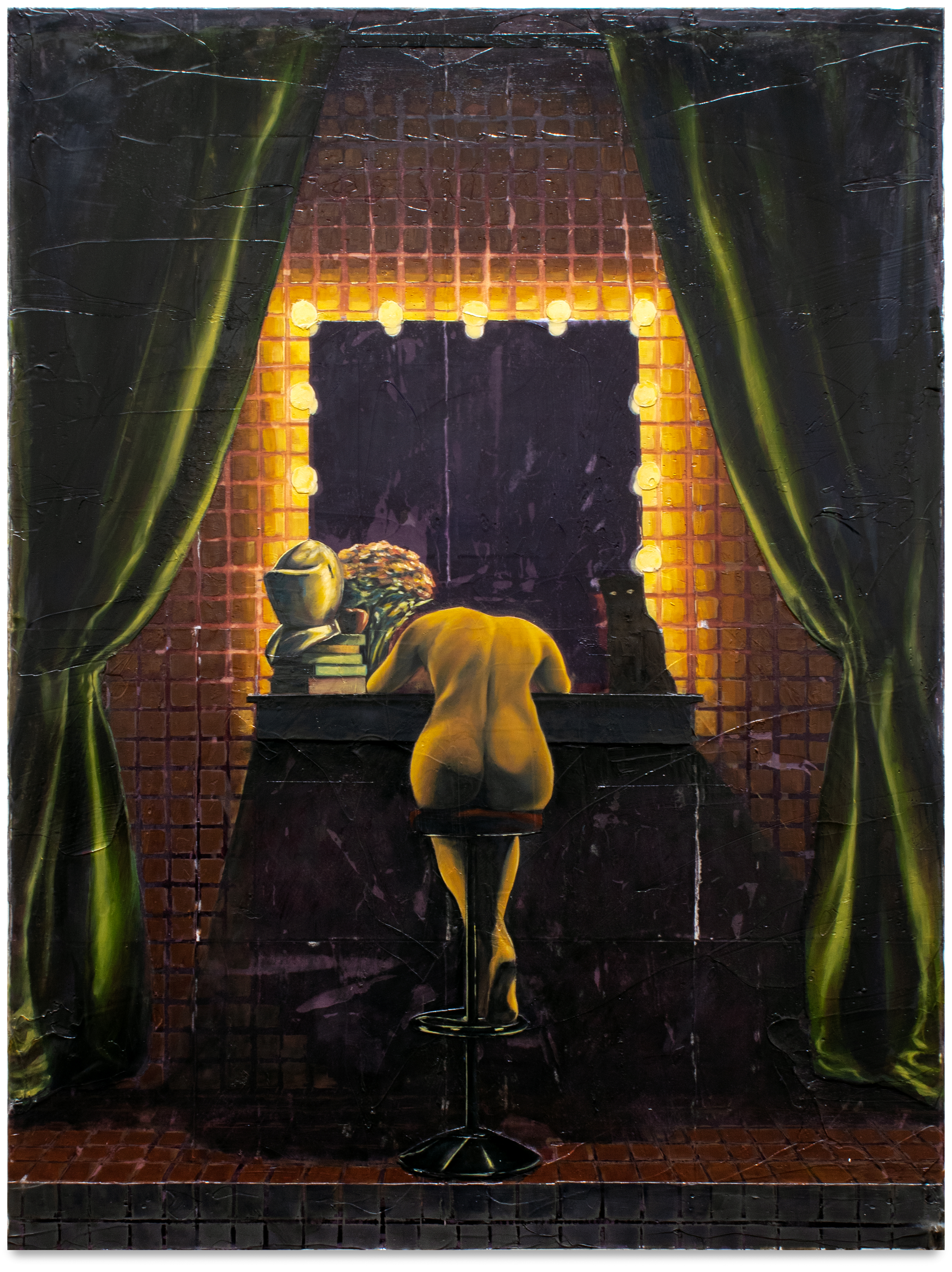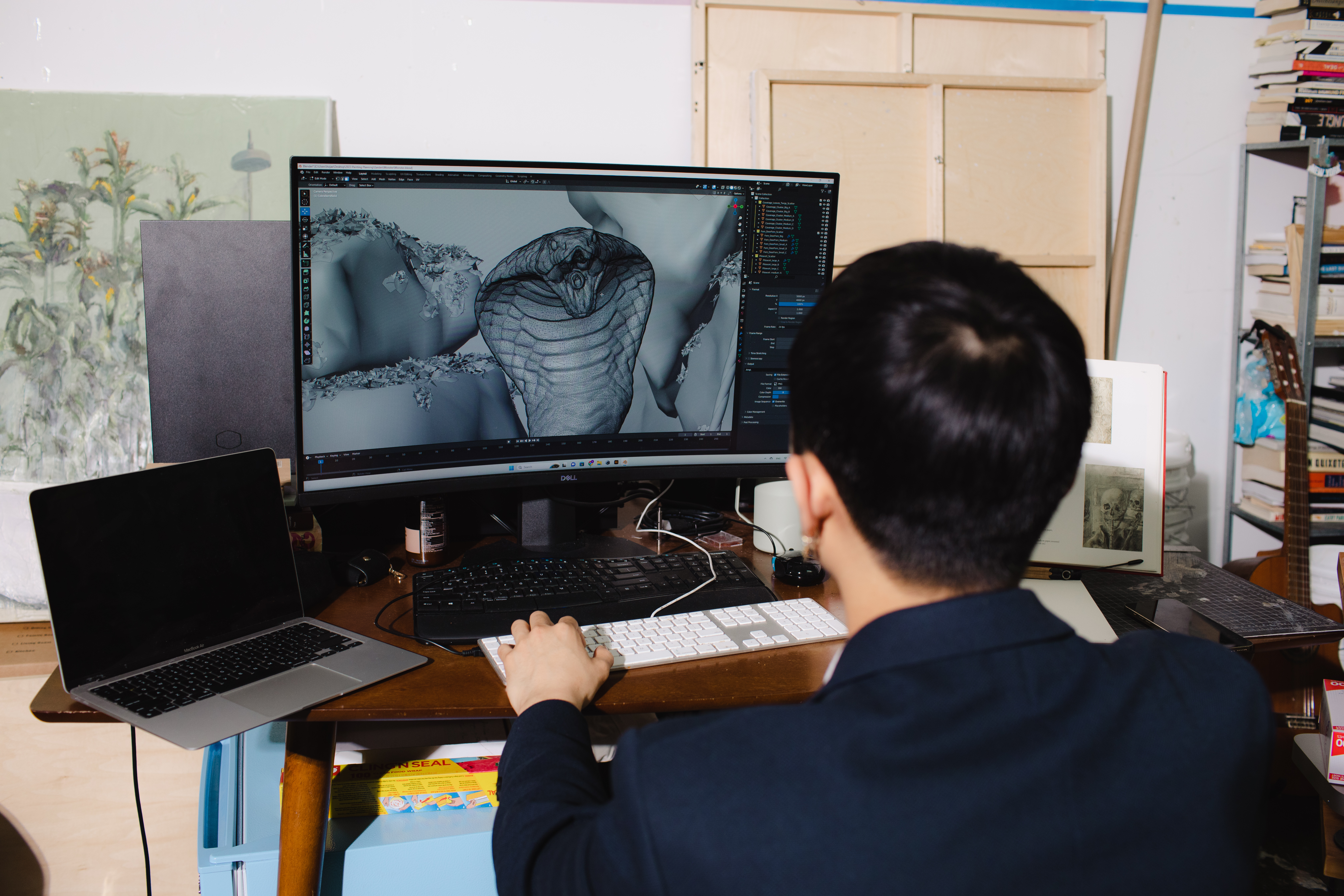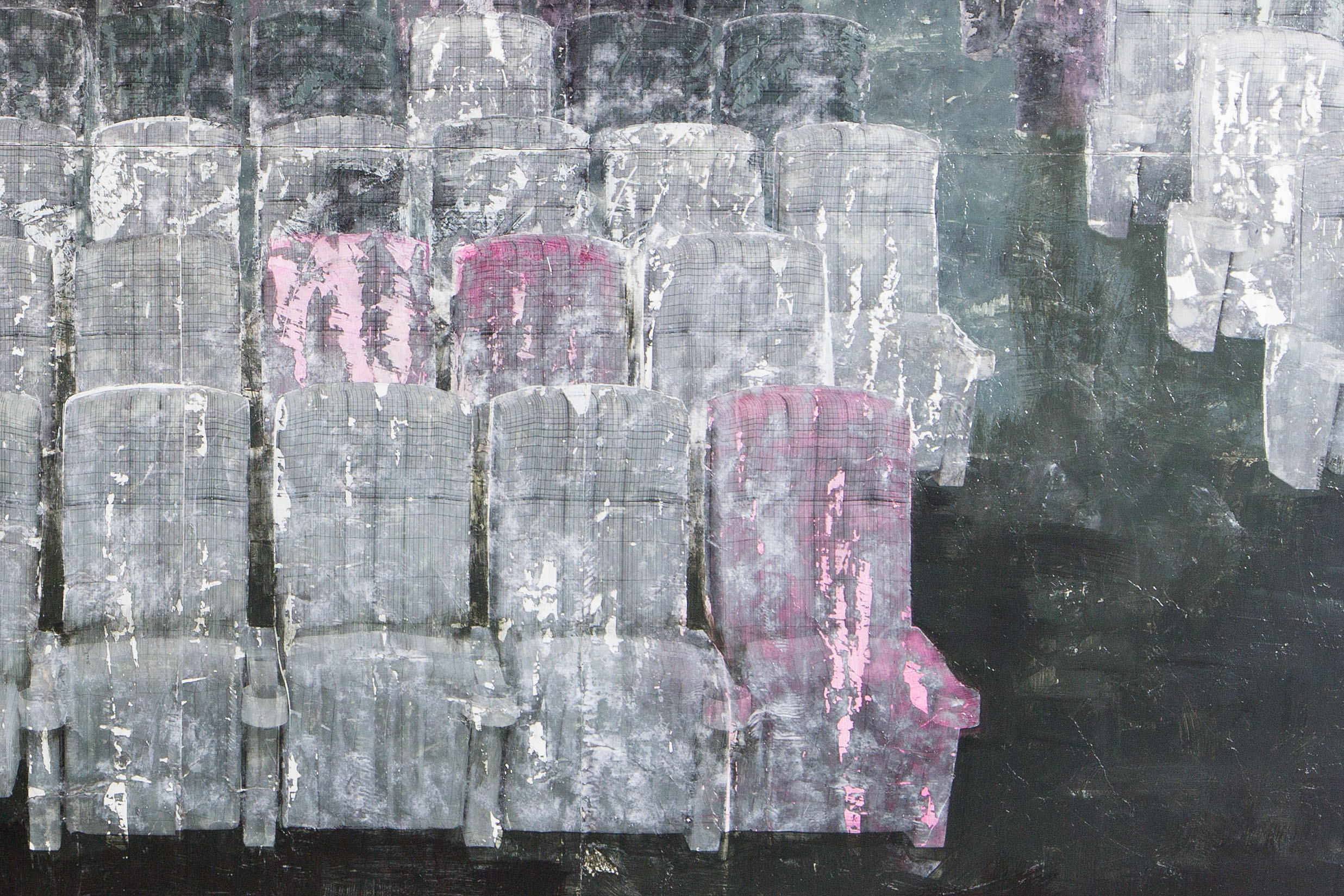HO JAE KIM’s artistic journey has taken
him from a childhood in one culture to a promising career in another. After
earning his BFA at the Rhode Island School of Design (RISD), he initially
aspired to become a graphic designer but later shifted his focus to painting.
His work features a distinct characteristic arising from his innovative use of
3D modeling programs and inkjet transfer techniques, which enable him to
achieve remarkable precision. His art has been showcased across the United
States, establishing him as an emerging figure in the contemporary
art scene. With upcoming shows to be held in Harper’s, Los Angeles (2023); and Nicodim Gallery, New York (2023), his works have been previously featured in Harper’s Chelsea, New York (2023); Galerie 75 Faubourg, Paris (2022); and Sotheby’s Institue of Art, New York (2018). His work is part of the Morgan Stanley Collection. He is currently based in New York.
![Ho Jae Kim, Day 15: Baggage, 2023. Oil, inkjet transfer, enamel and paper on canvas. 127 x 101.6 cm (50 x 40 in). Courtesy of the artist]()
![Ho Jae Kim, Day 12: Fountain, 2023. Oil, inkjet transfer, enamel and paper on canvas. 127 x 101.6 cm (50 x 40 in). Courtesy of the artist]()
![Ho Jae Kim, Waiting Room, 2022. Oil, inkjet transfer, enamel on canvas. 76.2 x 101.6 cm (30 x 40 in). Courtesy of the artist]()
![Ho Jae Kim, Day 1: Richard Parker, 2022. Oil, inkjet transfer, enamel and paper on canvas. 127 x 101.6 cm (50 x 40 in). Courtesy of the artist]()
![Ho Jae Kim, Day 14: Rehearsal, 2023. Oil, inkjet transfer, enamel and paper on canvas. 127 x 101.6 cm (50 x 40 in). Courtesy of the artist]()
![Ho Jae Kim, Day 18: Musician, 2023. Oil, inkjet transfer, enamel and paper on canvas. 127 x 101.6 cm (50 x 40 in). Courtesy of the artist]()
![Ho Jae Kim, Changing Room, 2022. Oil, inkjet transfer, enamel on canvas. 101.6 x 76.2 cm (40 x 30 in). Courtesy of the artist]()
Could you please walk me through your process? How do you typically begin your work?
When I have a promising idea in mind, I begin by creating pen drawings and rough sketches as reference images. Once I believe the idea has enough potential, I proceed to flesh out all the details in the drawing. My upcoming works, to be showcased in November at Harper’s, Los Angeles, draw inspiration from a short story I have written myself. I've been exploring the idea of creating paintings as part of a series, with each piece functioning as a scene from the narrative I've woven.
I knew you had a deep connection to reading, but I wasn't aware that you were also a writer. Has writing your own story influenced your approach to painting?
I’ve been contemplating how painting can thrive within an exhibition. I’ve wondered if there's a way to convey greater depth within a single artwork. Through this journey, I have come to recognize that, at least for me, crafting a cohesive series rather than standalone, sporadic paintings provides me with a better opportunity to communicate something truly impactful. I aim to convey a message or meaning akin to a story, and I've realized that a single piece of art has its limitations. When assembled together, I envision the entire body of work functioning like a musical symphony, each part contributing to a harmonious movement.
So a symphony, in your case, would be analogous to a series with each individual painting correlating to a movement. I noticed your works are grouped into larger themes such as Butterfly Dream (2021), Homunculus (2021-22), Machines (2019-21), Purgatory (2021-22), and Carousel (2023). Do you begin by establishing an overarching theme for the series before creating individual pieces?
Yes, I approach my work as if I were writing a book. Similar to authors like Haruki Murakami and Franz Kafka, my aim is to explore a common theme while weaving distinct characters and narrative plots into each piece. One concept I've dedicated considerable time to is the notion of the 'in-between' or liminal space, with the goal of presenting it in a more accessible manner. I've adopted this concept of 'Purgatory' from Dante’s Divine Comedy where souls await redemption and eventual entry in Heaven; this now serves as the overarching theme of my works. For each series, I work on developing a specific theme to build a cohesive body of work around it.
![Ho Jae Kim, Day 8: Laundry List, 2023. Oil, inkjet transfer, enamel and paper on canvas. 127 x 101.6 cm (50 x 40 in). Courtesy of the artist]()
![Ho Jae Kim, A Thought, 2023. Oil, inkjet transfer, enamel and paper on canvas. 76.2 x 50.8 cm (30 x 20 in). Courtesy of the artist]()
Your work seems to require meticulous utilization of 3D modeling programs to create preliminary renderings before applying paint. Has this tool been instrumental in achieving the depth you aim to bring to life? If so, in what ways?
Certainly. Creating a rendering using a 3D modeling program is closely tied to one of my major inspirations, Piero della Francesca, an Italian painter from the Early Renaissance. Working with rendering programs allows me to achieve a similar mathematical understanding of space, akin to Piero's approach. In his works, he meticulously calculated spatial relationships, the contours of figures, and object proportions with precision. It seems as though he contemplated the broader concept of humanity rather than the intricate details of individual subjects.
![A view of 3D modeling program. Courtesy of the artist. Photo: Quyn Duong]()
![A photo of preliminary drawings taken from studio visit. Aug 2023.]()
Tracking back to your early works, I’m interested in learning more about Theater Seats (2016-17). Was this your first official work after graduating? Unlike your recent pieces like Purgatory or Carousel, it doesn't feature any human figures despite the setting. How does it connect to your current artistic practice?"
Created during my undergraduate years, Theatre actually marked my initial foray into using a 3D modeling program as a creative tool. The next challenge I encountered was the transition from the digital realm to the physical, and that's when the idea of fresco painting came to mind. In the medieval era, when masters worked on frescoes, they utilized life-sized renderings of cartoons – comprehensive preparatory drawings – in their studios. This was necessary due to the limited timeframe for applying paint in the fresco technique. Once the drawing and composition stages were complete, they would transport these renderings to the actual site and transfer the lines from the drawing onto the wall using a method involving poking holes and graphite transfers.
Inspired by this transfer technique, I began exploring inkjet transfers, which became a fundamental part of my artistic process. The dominant gray tones in my earlier works reflect the experimental phase I underwent while working with transfers and 3D modeling.
![Ho Jae Kim, Theater Seats, 2017. Oil, inkjet transfer, enamel on canvas. 183 x 244 cm (72 x 96 in). Courtesy of the artist]()
![(detail)]()
Even when observing the seats within the painting, I notice the recurring tile pattern, which persists in your later works like Laundry Day (2020), Lifeboat Simulation (2020), Actor (2021), and Day 3: Janitor (2022). Personally, it seems to serve as a distinctive visual marker that helps me identify your artistic style. Is this pattern chosen for its compositional and grid-like qualities in constructing space, or does it hold a deeper symbolic meaning for your work?
Yes, one of the primary reasons involves how a grid can effectively represent space as a compositional element, as well as the concept of purgatory. During my time as a restaurant manager, the restroom of the restaurant where I worked was entirely covered in tiles, on all sides of the room. While it served as a rare sanctuary for me, as it was the only place where I could have some time to myself, I also felt a sense of suffocation due to the confined space and the repetitive nature of being in there. It serves as my personal symbol of what purgatory represents, and it also functions as a geometric tool to construct a sense of space.
![Ho Jae Kim, Day 3: Janitor, 2022. Oil, inkjet transfer, enamel, and paper on canvas. 127 x 101.6 cm (50 x 40 in). Courtesy of the artist]()
![(detail)]()
![Ho Jae Kim, Songs of the Remaining Days, 2023. Oil, inkjet transfer, enamel and paper on canvas. 243.8 x 169 cm (96 × 66.5 in). Courtesy of the artist]()
![(detail)]()
From what you've mentioned, it appears you're inclined to devise their own narrative and world through your works while incorporating visual motifs derived from your personal memories and experiences. What is the ultimate goal that you aspire to achieve through your artistic endeavors?
Think about those awe-inspiring moments in nature, like sunrises and sunsets, or what you call 'bul-meong'*these days—elements that I believe captivate every human being inherently. Yes, one might be attached to different narratives and methodologies that may vary depending on their culture and background, but even before such consciousness, I believe there exists an innate attraction to certain things. For me, that's light.
Light enables me to depict things beyond what we can merely see, as it elevates the sublime qualities of nature. I would say that my artworks represent my ongoing exploration of how to capture and convey the essence of light. In fact, this was also the inspiration behind Carousel (2023), which was featured in the exhibition of the same name held at Harper's Chelsea earlier this year. Have you ever stood in front of a carousel at night? The way it's illuminated, the carnival music playing, and its rotation—there's an indescribable quality that draws you in. It's almost like a man-made sunset.
*"Bul-meong" refers to the act of spacing out while gazing at a burning fire, typically done during camping.
![Ho Jae Kim, Carousel, 2023. Oil, inkjet transfer, enamel and paper on canvas. Triptych: 243.8 x 518.2 cm (96 x 204 in). Courtesy of the artist]()
![Installation view of Carousel at Harper's Chelsea, 2023. Courtesy of Harper's Gallery and the artist]()
![Installation view of Carousel at Harper's Chelsea, 2023. Courtesy of Harper's Gallery and the artist]()
I see. What you aim to capture—the concept of sublime nature—seems to possess abstract qualities. Are there particular considerations you keep in mind when translating this onto the canvas? How do you maintain the essence of sublime nature while still making it concrete enough to fulfill its purpose?
For me, utility begins with legibility—a universally recognized theme, like the concept of waiting in purgatory, for example—and my ability as an artist to depict something recognizable. If the audience can identify an object or a figure and label it as a car or a janitor, I consider that a form of success. This is also why I invest significant time in determining the placement of objects rather than focusing solely on what is being painted. Once recognizable objects and figures are in place, forming a coherent relationship, that, I would argue, constitutes a scene. It's a way to comprehend the dynamics of what the figures are doing on the canvas. Only with this understanding can the audience engage with the painting on a deeper level.
Kim is featured in a group show Briefly Gorgeous at Songwon Art Center from Sep 1-9, 2023. For further details, please visit https://www.phillips.com/store/briefly-gorgeous







Swipe to see more images
Could you please walk me through your process? How do you typically begin your work?
When I have a promising idea in mind, I begin by creating pen drawings and rough sketches as reference images. Once I believe the idea has enough potential, I proceed to flesh out all the details in the drawing. My upcoming works, to be showcased in November at Harper’s, Los Angeles, draw inspiration from a short story I have written myself. I've been exploring the idea of creating paintings as part of a series, with each piece functioning as a scene from the narrative I've woven.
I knew you had a deep connection to reading, but I wasn't aware that you were also a writer. Has writing your own story influenced your approach to painting?
I’ve been contemplating how painting can thrive within an exhibition. I’ve wondered if there's a way to convey greater depth within a single artwork. Through this journey, I have come to recognize that, at least for me, crafting a cohesive series rather than standalone, sporadic paintings provides me with a better opportunity to communicate something truly impactful. I aim to convey a message or meaning akin to a story, and I've realized that a single piece of art has its limitations. When assembled together, I envision the entire body of work functioning like a musical symphony, each part contributing to a harmonious movement.
So a symphony, in your case, would be analogous to a series with each individual painting correlating to a movement. I noticed your works are grouped into larger themes such as Butterfly Dream (2021), Homunculus (2021-22), Machines (2019-21), Purgatory (2021-22), and Carousel (2023). Do you begin by establishing an overarching theme for the series before creating individual pieces?
Yes, I approach my work as if I were writing a book. Similar to authors like Haruki Murakami and Franz Kafka, my aim is to explore a common theme while weaving distinct characters and narrative plots into each piece. One concept I've dedicated considerable time to is the notion of the 'in-between' or liminal space, with the goal of presenting it in a more accessible manner. I've adopted this concept of 'Purgatory' from Dante’s Divine Comedy where souls await redemption and eventual entry in Heaven; this now serves as the overarching theme of my works. For each series, I work on developing a specific theme to build a cohesive body of work around it.


Swipe to see more images
Your work seems to require meticulous utilization of 3D modeling programs to create preliminary renderings before applying paint. Has this tool been instrumental in achieving the depth you aim to bring to life? If so, in what ways?
Certainly. Creating a rendering using a 3D modeling program is closely tied to one of my major inspirations, Piero della Francesca, an Italian painter from the Early Renaissance. Working with rendering programs allows me to achieve a similar mathematical understanding of space, akin to Piero's approach. In his works, he meticulously calculated spatial relationships, the contours of figures, and object proportions with precision. It seems as though he contemplated the broader concept of humanity rather than the intricate details of individual subjects.


Swipe to see more images
Tracking back to your early works, I’m interested in learning more about Theater Seats (2016-17). Was this your first official work after graduating? Unlike your recent pieces like Purgatory or Carousel, it doesn't feature any human figures despite the setting. How does it connect to your current artistic practice?"
Created during my undergraduate years, Theatre actually marked my initial foray into using a 3D modeling program as a creative tool. The next challenge I encountered was the transition from the digital realm to the physical, and that's when the idea of fresco painting came to mind. In the medieval era, when masters worked on frescoes, they utilized life-sized renderings of cartoons – comprehensive preparatory drawings – in their studios. This was necessary due to the limited timeframe for applying paint in the fresco technique. Once the drawing and composition stages were complete, they would transport these renderings to the actual site and transfer the lines from the drawing onto the wall using a method involving poking holes and graphite transfers.
Inspired by this transfer technique, I began exploring inkjet transfers, which became a fundamental part of my artistic process. The dominant gray tones in my earlier works reflect the experimental phase I underwent while working with transfers and 3D modeling.


Swipe to see more images
Even when observing the seats within the painting, I notice the recurring tile pattern, which persists in your later works like Laundry Day (2020), Lifeboat Simulation (2020), Actor (2021), and Day 3: Janitor (2022). Personally, it seems to serve as a distinctive visual marker that helps me identify your artistic style. Is this pattern chosen for its compositional and grid-like qualities in constructing space, or does it hold a deeper symbolic meaning for your work?
Yes, one of the primary reasons involves how a grid can effectively represent space as a compositional element, as well as the concept of purgatory. During my time as a restaurant manager, the restroom of the restaurant where I worked was entirely covered in tiles, on all sides of the room. While it served as a rare sanctuary for me, as it was the only place where I could have some time to myself, I also felt a sense of suffocation due to the confined space and the repetitive nature of being in there. It serves as my personal symbol of what purgatory represents, and it also functions as a geometric tool to construct a sense of space.




Swipe to see more images
From what you've mentioned, it appears you're inclined to devise their own narrative and world through your works while incorporating visual motifs derived from your personal memories and experiences. What is the ultimate goal that you aspire to achieve through your artistic endeavors?
Think about those awe-inspiring moments in nature, like sunrises and sunsets, or what you call 'bul-meong'*these days—elements that I believe captivate every human being inherently. Yes, one might be attached to different narratives and methodologies that may vary depending on their culture and background, but even before such consciousness, I believe there exists an innate attraction to certain things. For me, that's light.
Light enables me to depict things beyond what we can merely see, as it elevates the sublime qualities of nature. I would say that my artworks represent my ongoing exploration of how to capture and convey the essence of light. In fact, this was also the inspiration behind Carousel (2023), which was featured in the exhibition of the same name held at Harper's Chelsea earlier this year. Have you ever stood in front of a carousel at night? The way it's illuminated, the carnival music playing, and its rotation—there's an indescribable quality that draws you in. It's almost like a man-made sunset.
*"Bul-meong" refers to the act of spacing out while gazing at a burning fire, typically done during camping.



Swipe to see more images
I see. What you aim to capture—the concept of sublime nature—seems to possess abstract qualities. Are there particular considerations you keep in mind when translating this onto the canvas? How do you maintain the essence of sublime nature while still making it concrete enough to fulfill its purpose?
For me, utility begins with legibility—a universally recognized theme, like the concept of waiting in purgatory, for example—and my ability as an artist to depict something recognizable. If the audience can identify an object or a figure and label it as a car or a janitor, I consider that a form of success. This is also why I invest significant time in determining the placement of objects rather than focusing solely on what is being painted. Once recognizable objects and figures are in place, forming a coherent relationship, that, I would argue, constitutes a scene. It's a way to comprehend the dynamics of what the figures are doing on the canvas. Only with this understanding can the audience engage with the painting on a deeper level.
Kim is featured in a group show Briefly Gorgeous at Songwon Art Center from Sep 1-9, 2023. For further details, please visit https://www.phillips.com/store/briefly-gorgeous
© 2023 Radar